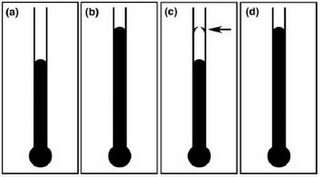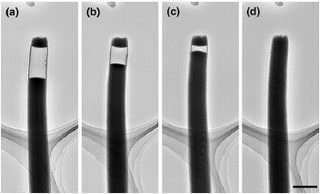July 26, 2006 feature
Scientists design simpler, more accurate nanothermometer

By using carbon nanotubes containing gallium for measuring temperature at the nanoscale, scientists have invented a new nanothermometer that works simply by heating and cooling the tubes.
As technology shrinks into the nanoscale range, the accessories of nanotechnology must also shrink – among these extra tools is a way to measure temperatures of the spaces surrounding nanoscale devices. Conventional (i.e. mercury) thermometers can only measure temperatures at the macroscopic scale (in the range of millimeters). Devices called thermocouples can measure temperatures at the microscale, but taking measurements at the nanoscale requires an all-together different tool.
A team of scientists from Australia and Japan, Zongwen Liu, et al., has recently improved upon a method for nano temperature measurement using nanothermometers consisting of carbon nanotubes filled with liquid gallium to develop a one-step measuring procedure. The nanotubes, which have diameters as small as 20 nanometers, can effectively measure temperatures of 175-660 degrees Fahrenheit.
“Due to the continuing miniaturization of existing technologies, it is becoming ever more important to know the temperature of current microelectronics and future nano-electronic and optoelectronic devices,” Liu told PhysOrg.com. “Each of these devices has its own optimal working temperature limit. Below this limit each device works efficiently. However, if the temperature exceeds the limit, not only are efficiency and proper operation impaired, but the device can be damaged. In fact, close to three quarters of all failures is due to thermal overload.”

Carbon nanotubes, discovered in the early ‘90s, are tiny, hollow cylindrical structures made of carbon molecules that are typically known for their strength and unique electrical properties. In 2002, scientists – including Yoshio Bando, coauthor of the current study – accidentally discovered that these carbon nanotubes can also act as tubes for measuring temperature when filled with gallium, much like a conventional mercury thermometer. In that study, the gallium expanded and contracted in response to temperature, and the initial temperature-height association was calibrated to estimate the temperature based on the gallium volume expansion.
Now, Liu, Bando and their colleagues have used a slightly different approach to simplify this method. When a carbon nanotube that contains gallium and has one open end is heated in air, the scientists found that the gallium will expand until the temperature is stable, at which time the gallium will begin to oxidize, starting at the top. The oxidation causes the formation of solid gallium oxide. When cooled, most of the gallium will contract, leaving behind a thin solid marker at the highest point. By reheating the tube under a microscope (transmission electron or scanning electron), the gallium will expand to the marker, revealing the original temperature of the tiny area of interest.
The oxidation-assisted technique improves upon the previous method in several areas. For one thing, the process is simplified because no calibration is required to record the original level of gallium. Also, several nanothermometers can easily be used in this case to verify temperature and bypass the previous risks of damage or loss when relying on a single thermometer. Finally, this technique demonstrated improved accuracy (better than 5%) over the original method.
“Many instruments and devices are sensitive to operating temperature and often work close to their critical thermal limits,” said Liu. “Among the applications that require precise temperature measurement at the nanoscale are polymer-based fuel cells and the microprocessors in
modern computers.”
Citation: Liu, Zongwen, Bando, Yoshio, Hu Junqing, Ratinac, Kyle and Ringer, Simon P. “A novel method for practical temperature measurement with carbon nanotube nanothermometers.” Nanotechnology 17 (2006) 3681-3684.
By Lisa Zyga, Copyright 2006 PhysOrg.com




















